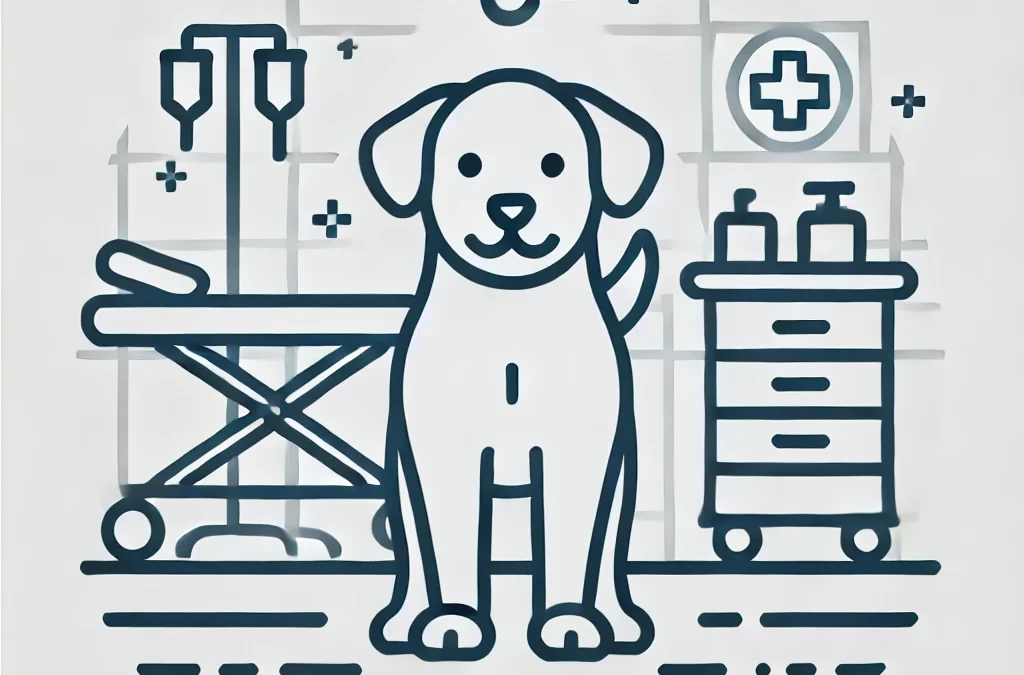
經過 TCMVET | 2024 年 11 月 20 日 | 狗癌症和腫瘤
犬傳染性腫瘤 (TVT) 是狗的一種獨特形式的癌症,主要透過直接接觸傳播。雖然獸醫介入通常是必要的,但人們對以家庭為基礎的支持性護理作為醫療治療的補充越來越感興趣。在本文中,我們將探討創新、自然和整體的實踐如何在家庭 TVT 管理中發揮關鍵作用,並強調與獸醫合作的重要性。
了解 TVT:快速概述
TVT 是一種傳染性腫瘤,會影響狗的外生殖器、口腔或鼻子。常見症狀包括:
- 可見腫瘤生長
- 出血或分泌物
- 受影響區域的不適或疼痛
主要治療包括化療(通常使用長春新鹼)、手術或放射治療。然而,對於一些寵物主人來說,這些治療可能並不總是能夠獲得或負擔得起。這就是家庭支持照護可以發揮作用的地方。
透過 TVT 徹底改變狗狗的家庭護理
1. 增強免疫力的營養
狗的免疫系統在對抗癌症方面發揮著至關重要的作用。提供營養豐富的膳食可以支持他們的整體健康。考慮:
- 精益蛋白質來源:火雞、雞肉和魚肉可維持肌肉量。
- 抗癌食物:藍莓、胡蘿蔔和青花菜含有抗氧化劑,可以對抗氧化壓力。
- Omega-3 脂肪酸:存在於魚油或亞麻仁油中,有助於減輕發炎。
專業提示:避免攝取高糖和穀物的食物,它們會加劇腫瘤的生長。
2. 自然療法和草藥
自然療法可以緩解並幫助控制 TVT 症狀。一些有前途的選擇包括:
- 薑黃(薑黃素):以其抗發炎和抗腫瘤特性而聞名。
- 川芎(四川獨生):一種傳統中草藥,被認為可以改善血液循環並支持癒合。
- CBD油:可以幫助減少發炎、控制疼痛並提高整體舒適度。
重要的:請務必諮詢獸醫以確定安全劑量。
3. 創造一個無壓力的環境
壓力會削弱狗狗的免疫系統。透過以下方式確保您的寵物有一個平靜舒適的環境:
- 提供遠離家庭噪音的安靜休息空間。
- 使用薰衣草精油擴散器等鎮定劑(在通風良好的房間內)。
- 進行輕鬆、低壓力的活動,讓他們保持活躍和快樂。
4. 傷口和腫瘤護理
如果存在外部腫瘤,它們可能會出血或感染。居家照護包括:
- 用鹽水溶液輕輕清潔受影響的區域,以防止感染。
- 使用獸醫批准的藥膏來促進癒合。
- 監測感染跡象,如發紅、腫脹或惡臭。
5. 加強腸道健康
接受 TVT 治療的狗經常會出現消化問題。益生菌和益生元可以改善腸道健康並增強營養吸收。優格(不添加糖)或獸用益生菌補充劑可以添加到他們的飲食中。
6.替代療法
- 指壓按摩:可以幫助改善血液循環並減輕疼痛。
- Homeopathy: 補救措施如 砷相簿 或者 崖柏 有時用於癌症支持(在獸醫指導下)。
家庭治療可以做什麼、不能做什麼
雖然這些方法可以提高您的狗的舒適度和整體健康狀況,但它們 無法取代專業醫療。 TVT 是一種嚴重的疾病,通常需要化療或其他獸醫治療才能治癒。家庭護理最好作為補充方法來改善您的狗的生活品質並支持康復。
整體方法是關鍵
在家治療 TVT 的想法並不是要尋找靈丹妙藥,而是要創造一個讓您的狗感到受到培育和支持的環境。透過將獸醫治療與創新的家庭護理實踐相結合,您可以為您的毛茸茸的朋友提供最佳的康復機會。
最後的想法
在家管理 TVT 需要奉獻精神、創造力以及與獸醫專業人士的合作。這不僅僅是治療疾病;這是為了讓你的狗的生活恢復希望、健康和幸福。透過這種整體方法,寵物主人可以在狗狗的康復過程中發揮積極作用,確保它們得到應有的愛和照顧。

經過 TCMVET | 2024 年 11 月 18 日 | 狗癌症和腫瘤
狗的白血病通常被稱為“無聲的疾病”。當症狀出現時,疾病可能已經進展。但是,如果我們能夠在這個隱藏的敵人大聲攻擊之前聽到它微妙的低語呢?識別狗白血病的早期症狀不僅可以挽救它們的生命,還可以大大提高它們的生活品質。讓我們開始對這些早期預警訊號進行非常規的探索,將臨床見解與犬類護理的整體方法結合。
解讀微妙的暗示
白血病經常偽裝成其他不太嚴重的疾病。早期發現需要敏銳的眼睛和對狗行為的直觀理解。以下是需要注意的低調跡象:
- 異常疲勞或嗜睡 你平常精力充沛的小狗突然更喜歡閒逛而不是玩耍。這種昏昏欲睡不僅僅是衰老或艱難的一天造成的。這是身體發出訊號的方式,顯示更深層的東西可能出了問題。
- 牙齦和舌頭蒼白 健康的牙齦應該是泡泡糖粉紅色。如果您的狗的牙齦或舌頭呈蒼白或白色,則可能表示貧血,這是由紅血球生成量低引起的白血病的常見早期症狀。
- 持續或不明原因的感染 對治療沒有反應的頻繁感染可能表示免疫系統較弱。白血病會損害白血球功能,使狗狗容易受到細菌、真菌或病毒的侵襲。
- 淋巴結腫大 淋巴結腫大,尤其是頸部、肩部或後腿周圍的淋巴結腫大,是出現問題的明顯跡象。雖然並非白血病獨有,但這是一個值得研究的跡象。
- Unexplained Weight Loss 患有白血病的狗儘管保持食慾,但體重可能會減輕。發生這種情況是因為疾病劫持了身體的資源,導致肌肉萎縮和能量消耗。
- 瘀傷或出血 注意皮膚下方是否有紅色或紫色的小點(瘀點)或不明原因的瘀傷。白血病會破壞血小板的產生,導致凝血問題。
- 食慾不振或嘔吐 雖然這些症狀是許多疾病的常見症狀,但它們的持續存在可能預示著白血病等潛在問題。
為什麼早期檢測很重要
越早發現白血病,治療效果越好。許多狗主人認為偶爾嗜睡或食慾不振是正常的,尤其是老年狗,但忽視這些跡象可能意味著錯過及時幹預的機會。常規血液檢查是在白血病進展之前發現它的簡單而強大的工具。
超越臨床:情感聯繫
狗是隱藏痛苦的高手。通常,行為改變,例如退出家庭互動或顯得“不合群”,是痛苦的早期情緒暗示。與您的寵物建立深厚的聯繫可以讓您了解這些微妙之處。
犬白血病的整體觀點
雖然化療和類固醇等傳統治療方法很常見,但整合整體護理可以提高狗狗的生活品質。以下是一些選項:
- 營養支持
- 包括富含抗氧化劑的食物,如藍莓和菠菜,以增強免疫系統。
- 骨湯提供必需的營養並有助於維持食慾。
- 天然補充品
- 薑黃:它的抗炎特性可以支持整體健康。
- 靈芝蘑菇:以其增強免疫力和抗癌特性而聞名。
- 壓力管理
- 溫和的按摩和使用薰衣草等對狗安全的油進行芳香療法可以緩解壓力,而壓力可能會加劇症狀。
- 草藥療法
- 傳統中藥草藥如 黃耆 和 黨神 可以支持免疫力和能量水平。
預防措施:我們能保持領先嗎?
雖然白血病並不總是可以預防,但某些措施可能會降低風險因素:
- 定期獸醫檢查:年度血液檢查可以及早發現異常狀況。
- 限制接觸毒素:避免在寵物周圍使用殺蟲劑、除草劑和吸煙。
- 保持健康飲食:均衡、營養豐富的飲食可以保持狗狗的免疫系統強壯。
何時採取行動
如果您的狗表現出不只一種早期症狀,請不要等待。立即諮詢獸醫。簡單的血液檢查可以提供答案,如果診斷出白血病,早期介入可以顯著延長狗的生命。
希望的一瞥
白血病並不一定意味著死刑。隨著獸醫護理、整體支持和寵物父母堅定不移的愛的進步,被診斷出患有白血病的狗可以過著充實的生活。關鍵在於提高警覺、教育並採取積極措施。
結論
狗狗罹患白血病的早期症狀就像風中的低語一樣,很容易被忽視,但聽到卻至關重要。透過密切注意狗狗的身體和情緒信號,您可以在這個隱藏的敵人佔據上風之前將其攔截。畢竟,我們的四足夥伴在需要的時候理應得到我們最好的幫助。

經過 TCMVET | 2024 年 11 月 18 日 | 食品與健康
對於我們毛茸茸的朋友來說,確保他們的關節健康與滿足他們的基本需求一樣重要。關節補充劑不僅僅是預防性護理;它們是寵物通往更長壽、更幸福生活的橋樑。但真正定義什麼 最好的 寵物關節補充劑?讓我們擺脫平凡,探索非常規但有效的解決方案,重新定義關節健康。
重新思考關節護理:不只是葡萄糖胺
多年來,葡萄糖胺和軟骨素一直主導著寵物補充劑產業。雖然它們很有效,但僅依賴這些成分可能會忽略其他創新解決方案。現代關節補充品正在整合:
- Omega-3 脂肪酸:以其抗發炎特性而聞名,可以大大改善關節活動度。尋找含有綠唇貽貝萃取物的補充劑,綠唇貽貝萃取物是 omega-3 的有效來源。
- 薑黃和薑黃素:這些天然成分作為強大的抗氧化劑而受到關注,可以減少發炎並減緩軟骨破壞。
- 玻尿酸:這種成分通常與護膚品聯繫在一起,現在被用於寵物補充劑中,以改善關節潤滑,確保運動更順暢。
根據寵物的生活方式量身訂做關節護理
沒有兩隻寵物是相同的。他們的關節健康需求因品種、年齡、活動量甚至飲食而異。不要採用一刀切的方法,而是考慮以下量身訂製的解決方案:
- 對於高級寵物:選擇富含膠原蛋白和 MSM(甲基磺酰甲烷)的補充劑,以支持軟骨修復並改善活動能力。
- 對於活躍品種:尋找專注於肌肉恢復和關節緩衝的成分,例如齒葉乳香(Boswellia serrata),一種傳統醫學中使用的草藥。
- 對於小型品種:選擇較小、易咀嚼的補充劑或可以輕鬆添加到食物中的液體補充劑。
整體關節健康:超越補充劑
最好的關節補充劑只是等式的一部分。支持關節健康需要採取整體方法:
- 體重管理:超重會對關節造成不必要的壓力。均衡的飲食加上正確的補充劑可確保您的寵物保持理想的體重。
- 低強度運動:游泳和有控制的步行等活動有助於保持關節靈活性,而不會過度勞累。
- 定期獸醫檢查:與獸醫一起監測寵物的關節健康有助於及早發現問題並調整他們的護理計劃。
創新形式:製作適合寵物的補充劑
強迫你的寵物吞下藥丸的日子已經結束了。現在最好的補充品有:
- 美味咀嚼物:寵物誤認為零食的風味選擇。
- 粉末配方:輕鬆與餐點混合,非常適合挑食的人。
- 油滴:對於有牙齒問題或不喜歡固體的寵物來說很方便。
DIY關節健康:你可以自己製作補充品嗎?
如果您是一位親力親為的寵物父母,自製補充劑可能是一種選擇。骨湯是葡萄糖胺和軟骨素的極佳天然來源。將其與薑黃醬(由椰子油和黑胡椒製成以利於吸收)混合,就得到了強大的抗炎混合物。
然而,在開始 DIY 解決方案之前,請諮詢您的獸醫,以確保正確的劑量以及與您寵物的飲食的兼容性。
聚焦獨特成分
寵物補充劑產業中獨特的、有科學依據的成分正在增加,例如:
- 蝦紅素:一種有效的抗氧化劑,可減少氧化壓力並促進關節恢復。
- 蛋殼膜:膠原蛋白、葡萄糖胺和透明質酸的天然來源,可支持軟骨修復和整體關節健康。
- 四角白粉藤:一種鮮為人知的草藥,傳統上用於治療骨骼和減輕關節疼痛。
如何選擇合適的補充劑
購買關節補充劑時,請記住以下因素:
- 透明度:尋找公開所有成分及其劑量的品牌。
- Third-Party Testing:確保產品經過安全性和功效測試。
- 獸醫批准:獸醫推薦的補充劑通常有臨床支持。
結論:共同努力改善健康
最好的寵物關節補充劑不僅僅是一種產品,它還是對寵物健康的生活方式承諾的一部分。透過採用創新成分、根據寵物的需求量身定制護理並採用整體方法,您可以確保您的寵物充分享受每一次跳躍、奔跑和搖尾巴。
請記住,關節健康的旅程不一定是平凡的。是時候跳出零食袋的束縛,給予您的寵物真正應有的照顧了。

經過 TCMVET | 2024 年 11 月 16 日 | 狗癌症和腫瘤
當我們聽到「腫瘤」這個詞時,我們的腦海常常會跳到最壞的情況:癌症。然而,並非所有腫瘤都是惡性的。事實上,狗的良性腸道腫瘤遠沒有那麼危險,通常可以透過正確的方法進行有效治療。本文深入探討這些良性生長的細微差別,幫助您了解原因、症狀和管理策略。
什麼是良性腸道腫瘤?
良性腸道腫瘤是在狗的胃腸道中發生的非癌性生長。雖然它們不會侵入周圍組織或擴散到身體的其他部位,但如果它們長到足以阻塞腸道或乾擾正常功能,它們的存在仍然會導致不適或消化問題。
犬良性腸道腫瘤的常見類型:
- 腺瘤:由腸道內壁的腺細胞發育而來。
- 平滑肌瘤:源自腸壁的平滑肌細胞。
- 息肉:從腸壁突出的小生長物。
原因:為什麼會出現這些腫瘤?
雖然狗良性腸道腫瘤的確切原因尚不清楚,但有幾個因素可能會導致:
- Genetics:某些品種,如德國牧羊犬和柯利牧羊犬,可能有這種傾向。
- Chronic Inflammation:長期胃腸道發炎會增加異常細胞生長的風險。
- 飲食因素:缺乏纖維的劣質飲食可能會導致息肉的形成。
症狀:要注意什麼
良性腫瘤通常生長緩慢,一開始症狀很微妙。隨著時間的推移,隨著腫瘤的增大,可能會出現以下症狀:
- 慢性嘔吐或腹瀉:由於刺激或部分阻塞。
- 減肥:如果腫瘤影響營養吸收。
- 血:亮紅色或暗紅色,取決於腫瘤的位置。
- Abdominal Pain:如果腫瘤導致腹脹或阻塞。
- 食慾改變:飢餓和拒絕進食之間的波動。
紅旗:任何持續的胃腸道症狀都需要去看獸醫進行徹底評估。
診斷:找出問題
診斷良性腸道腫瘤需要結合多種技術:
- 體檢:觸診腹部是否有腫塊。
- 影像學:X 光或超音波可觀察腸道。
- 內視鏡檢查:相機輔助檢查,用於觀察並可能對生長進行活檢。
- 活檢:最終診斷來自於分析組織樣本以確定腫瘤是否是良性的。
治療:治療良性腫瘤的選擇
雖然良性腫瘤不會危及生命,但它們通常需要治療以減輕症狀或預防併發症。
1. 手術切除
- 什麼時候需要手術? 如果腫瘤引起阻塞或嚴重症狀。
- 結果:手術通常可以治癒良性生長,狗術後恢復良好。
2. 內視鏡息肉切除術
- 它是什麼? 一種透過內視鏡切除息肉或小腫瘤的侵入性較小的方法。
- 優點:恢復時間更短,不適感最小。
3.飲食調整
- 為什麼它有幫助:高纖維飲食可以減少發炎並支持治療後腸道癒合。
- 應包括的食物:南瓜、煮熟的地瓜和獸醫推薦的粗磨食物。
4. 監控
- 對於小腫瘤:定期檢查以監測生長情況,無需立即介入。
預後:會發生什麼
如果治療得當,良性腸道腫瘤通常預後良好。定期去看獸醫和追蹤對於確保腫瘤不會復發或引起進一步的問題至關重要。
預防:你能降低風險嗎?
雖然不可能保證預防,但以下步驟可能會降低您的狗狗罹患良性腸道腫瘤的風險:
- 均衡飲食:包括優質蛋白質、健康脂肪和充足的纖維。
- 定期去看獸醫:例行檢查可以及早發現潛在問題。
- 留意症狀:早期發現通常會帶來更簡單、侵入性更小的治療。
獨特的視角:腸道與整體健康
有趣的是,狗的腸道健康與它們的整體健康密切相關。良性腫瘤的存在可能預示著潛在的不平衡,例如發炎或不良飲食,值得關注。治療腫瘤只是整個旅程的一部分——解決根本原因可以確保您的狗保持健康和活力。
結論:化挑戰為機遇
狗的良性腸道腫瘤雖然令人擔憂,但是可以控制的,而且通常是可以治癒的。它們提醒您優先考慮腸道健康,提供營養膳食,並與獸醫保持牢固的合作關係。只要細心和警惕,您的毛茸茸的伴侶就可以繼續享受幸福、舒適的生活。

經過 TCMVET | 2024 年 11 月 16 日 | 狗癌症和腫瘤
淋巴瘤是狗最常見的癌症之一,雖然它對寵物主人來說可能是毀滅性的,但提供舒適和生活品質至關重要。透過將現代獸醫護理與整體方法相結合,您可以幫助您的狗在這段充滿挑戰的旅程中感到被愛、安全和舒適。以下是如何實現這一目標的全新視角。
1. 個人化營養:舒適餵養
患有淋巴瘤的狗經常會出現食慾和消化困難。以下是如何調整他們的飲食:
- 抗發炎食品:添加魚油中的 omega-3 脂肪酸,對抗發炎。菠菜或地瓜等新鮮、稍微煮熟的蔬菜也可以支持免疫健康。
- 美味的選擇:使用溫熱的骨頭湯或羊奶使餐點更開胃且更容易消化。
- 避免碳水化合物過量:由於癌細胞靠糖而繁殖,因此應減少高血糖食物並專注於瘦蛋白和健康脂肪。
2. 營造寧靜的環境
平靜舒適的空間有助於減輕狗狗的壓力並改善它們的整體健康狀況:
- 矯形寢具:提供柔軟、有支撐效果的床,以緩解關節疼痛和不適。
- 溫度控制:根據需要使用加熱墊或冷卻墊以確保它們舒適,尤其是在對溫度敏感的情況下。
- 舒緩的聲音:輕柔的音樂或白噪音有助於營造寧靜的環境,尤其是在他們看起來焦躁或焦慮的情況下。
3. 緩解症狀的自然療法
整體療法可以是傳統療法的絕佳補充:
- CBD油:CBD 油以其抗炎和止痛特性而聞名,可以幫助減輕疼痛和改善食慾。
- 草藥補充劑:薑黃(用於發炎)和黃耆(用於免疫支持)等草藥可能是有益的,但在使用它們之前請諮詢您的獸醫。
- 指壓按摩:這些技巧可以幫助緩解緊張、改善血液循環並提供鎮靜效果。
4. 適度運動和精神刺激
雖然應避免劇烈活動,但輕度運動和精神投入對於情緒和身體健康至關重要:
- 短途步行:保持簡短並按照您的狗的節奏進行,以避免過度勞累。
- 互動玩具:拼圖餵食器或鼻煙墊可以讓您的狗狗保持精神刺激,同時節省能量。
- 溫柔的玩耍:簡單的遊戲,例如用毛絨玩具拔河或輕輕地撿東西,可以帶來歡樂,但不會造成疲勞。
5. 與您的獸醫進行開放式溝通
與您的獸醫合作對於確保您的狗的舒適至關重要:
- 疼痛管理:定期評估他們的疼痛程度並根據需要調整藥物。
- 安寧療護計劃:向您的獸醫詢問安寧療護,例如皮質類固醇,這可以幫助減輕淋巴瘤症狀。
- 頻繁監控:追蹤行為、食慾或精力的變化,以便及時解決問題。
6. 情感支持:愛的療癒力量
您的陪伴和照顧是狗狗最大的安慰來源:
- 一致的慣例:狗狗在可預測的時間表中找到安全感,因此請保持定期餵食、散步和休息時間。
- 溫和的互動:輕聲說話,多給他們擁抱,如果他們想休息,請尊重他們的訊號。
- 珍惜的時刻:透過做您的狗喜歡的活動來創造有意義的回憶,例如躺在陽光下或溫和的汽車之旅。
7. 為下一步做好準備
隨著淋巴瘤的進展,關注他們的生活品質至關重要:
- 生活品質評估:HHHHHMM 量表(傷害、飢餓、補水、衛生、幸福、行動能力以及好日子多於壞日子)等工具可以幫助您做出有關他們護理的決定。
- 臨終規劃:考慮諮詢寵物臨終關懷服務,以確保您的狗的最後幾天平靜且無痛苦。
結論:慈悲之旅
幫助患有淋巴瘤的狗不僅僅是控制症狀,而是珍惜在一起的每一刻。透過將周到的獸醫護理與整體療法和充足的愛相結合,您可以為您的狗提供它們應有的舒適和尊嚴。請記住,您的狗可能正在與淋巴瘤作鬥爭,但它們將永遠得到您堅定不移的支持和喜愛。





